25 Funny and Weird Victorian Era Photos

When we think about Victorian era photos, most of us imagine gloomy images depicting people engaged in their everyday work with no time left for enjoyable pastime activities. Of course, these facts about Victorian photographs is partly true, and the post-mortem photography that is rooted in that period is a serious proof.
However, my aim while writing this article was to show the representatives of that epoch not only in a grim way, but also “tell” about the funny and joyful moments of their lives.
25 Victorian Era Photos That Aren’t Serious
What are the typical features of Victorian photographs? Actually, there are lots of interesting things worthy of your attention. So, let’s study them in detail.
1. A Victorian Couple Trying Not To Laugh

Some things don’t change over time and people you can see in this photo behave exactly the same way as any of us does in front of the camera. A bit uneasy with sincere smiles, they are showing that they aren’t used to being photographed.
- Read more about famous photographers to learn the names of those, who affected the history.
2. Snow Lady

Using only a shovel and scissors, photographers set up and modeled the “Snow Lady” in the garden. They didn’t use any base, a stick or wire to support the head, body, or arms.
3. Unusual Victorian Lady
This is a great example of funny old photos taken in the middle of the 19th century. The model wanted to stay anonymous, maybe because of her non-common way of posing.
4. Awkward Victorian Family Photo

People of Victorian era were accustomed to a regular, accepted manner of taking family images and everybody perfectly knew the pose he/she had to take. This family decided to go another way, which resulted in such a weird photo.
5. Piggy Nose
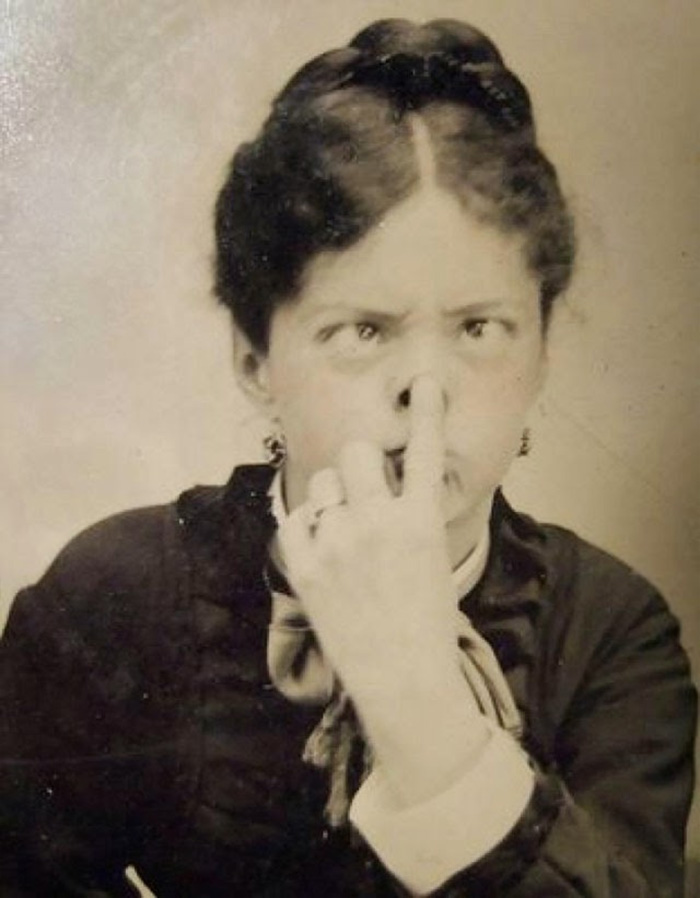
Seeing this photo somewhere online, you may doubt that it belongs to the collection of old Victorian pictures. A woman behaves very playfully, which may remind you of one of the Snap chat filters frequently used nowadays.
6. Vintage Humor

Living at that period in London was rather a difficult thing, as the city was overcrowded. From time to time residents didn’t even get enough drinking water. Anyway, that didn’t stop them from making jokes and taking funny Victorian photos.
7. Tsar Nicholas II Goofing Around

Nothing really extraordinary. Just Tsar Nicholas II dawdling with his friends.
8. Unknown Victorian in Mid-Jump

Is there any chance that this sample of Victorian era photographs gave an impetus to the modern trend of posing in the same way in front of the camera? Who knows!
- Check out these the most iconic photos that changed the world.
9. Miss Barton Dressed in a Late Victorian Tennis Outfit
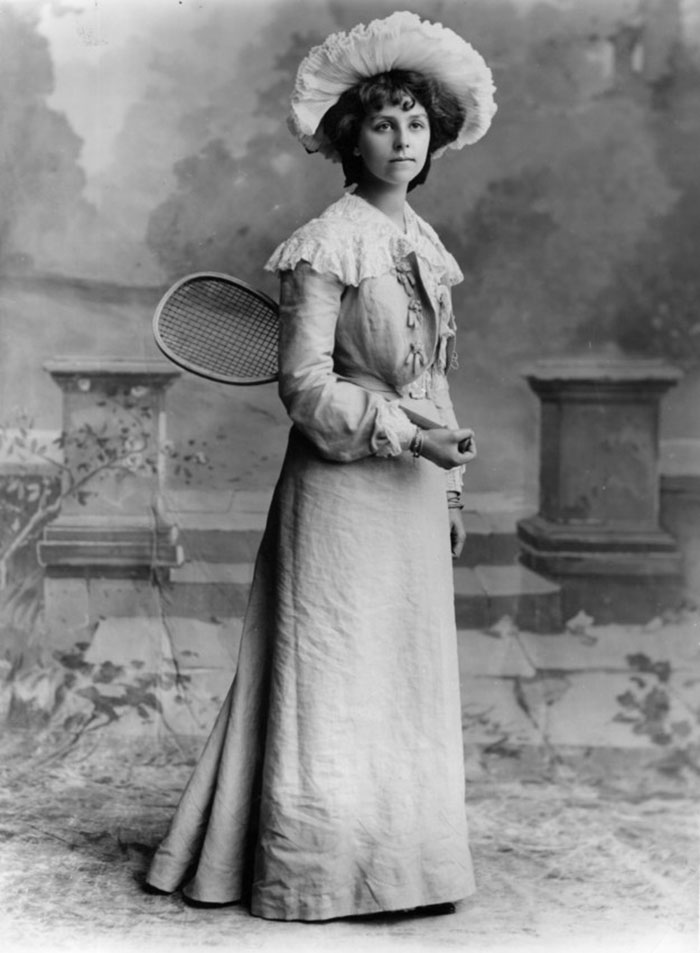
You have probably understood that outfit in the Victorian era had little to do with practically, and this tennis uniform isn’t an exception. I can hardly imagine an athlete running with a rocket to hit the ball in such attire!
10. Men Dressed in Drag in the Victorian Era

Victorian era people didn’t pay much attention to gender issues and topics related to different trans lifestyles, though most of them followed cross dressing principles.
- Have a look at today’s creative photography ideas.
11. A Woman Riding a 'Scorcher' in St James' Park

This lady looks absolutely satisfied and confident riding a bike in St James’ Park, London.
12. Evelyn Winchester

Another wonderful example of old Victorian photos with a woman being the main character. Evelyn Winchester looks absolutely happy, enjoying the everyday moments of her life.
13. Fashion Victorians Women

Modern models can even envy these gorgeous Victorians being absolutely content with their stylish look. But what has happened to their fingers?!
14. Kid Pulling a Funny Face

Looking at the photo of this kid, I can’t help imagining another one Dennis the Menace, making the life of his neighbors less peaceful.
15. Cakewalk Dance

Who said that people living in the Victorian era were sad? Just look at how happy they are dancing together!
16. A Unique Tea Setting for Two

Among many Victorian pictures of ladies, this one has the most notorious fame, showing a woman known as Teacup Sally, who made a living by working in brothels.
17. Say That Again, and I'll Dip You In

Just look at this couple! Real, sincere emotions of loving people!
18. Vacation Sports at the Seaside

Why do many people think that women can’t be real friends?! Clever, pretty, athletic!
19. Courting in the 1800s Never Looked Better

This is one of those romantic Victorian pictures that can’t leave viewers indifferent. By the way, did you pay attention to the quality of the photo? This is something incredible!
20. Victorian Selfie

We all know how to take a selfie. But it turned out that Victorians also did it quite skillfully. Though the quality of such Victorian era photos isn’t the best, the emotions we can see save the situation.
- Look at these selfie ideas for your photos.
21. Smiling Victorians

There aren’t many smiling Victorian pictures, since it was very tiresome to keep a smile for at least several minutes as photographs were taken at a long exposure. In most cases, a photographer either got a blurred picture or a photo with unnatural, strained expressions.
22. Smiling Little Girls

In all times girls wanted to look pretty and Victorian ladies used all possible methods to give their hair a bit stylish look.
They took strips of fabric and tie their locks to them for a night. In the morning, they got nice curls. This looks gorgeous in photos.
23. Man Pulling a Funny Face

It is rather a rare case that you can see such a smiling Victorian man. He is really happy!
24. A Group of Smiling Edwardians

Apparently, this Victorians picture was taken at a party. It is a pity that the background is slightly blurred, but that wasa commonproblem for that era.
25. Slicker-Looking Guy

A man with a cigar and his bellowed woman! So romantic!
Victorian Death Photography History
The tradition of photographing alivehumans together with their dead relatives seems like real nonsense to modern people. Looking at such images, we can get goose bumps, but for Victorians that was a way of going through the heartsick of losing their dearest family members and mimicking the feeling of being together again.
These creepy Victorian photos often depict a family member passed away, infants looking asleep, deceased young ladies placed in such a way that they look elegant, etc.
Unfortunately, at that time people suffered from all kinds of epidemics like typhus, cholera and diphtheria, which couldn’t but influenced the way people behaved and perceived their life. The Queen even made mourning a trend.
There appeared trinkets of memento mori, enforcing people to “remember they must die”. These accessories were available in different forms and were frequently featured in Victorian postmortem photography stories.
It turned out that living people though more about death than life. So, they cut locks of hair from the dead and put them in Victorian memento mori jewelry, created wax death masks, and incorporated death symbols into painting and sculpture.
In the middle of the 19th century, people got interested in photography, which was also shaped by memento mori calling.
The first popular form of photography was daguerreotype. It was a tiny but very detailed image on a piece of silver. Though it was perceived as an expensive artwork, the price was still lower than for a painted portrait.
Responding to the market demand, more and more photographers started creating these silver plates, which eventually reduced the cost. Later, silver was replaced by glass, metal or paper.
Death portraiture gained immense popularity. Victorian nurseries were full of babies dying from different illnesses, which initiated parents to photograph with their infants while they were still alive. That was the only physical reminder of their cute babies.
The healthcare was developing, so the number of dying children reduced greatly, which mean decreased demand for death Victorian pictures for sale. Citizens were happy to photograph together with their kinds in life.
Victorian Death Photography Facts
The Victorian era is known for many strange or even creepy rituals, like memorial photography. After-death portraits were popular among many people. I have prepared some other facts about this type of photography that may be of interest to you.
Artists Would Paint Open Eyes Over the Deceased's Eyelids
To make deceased people look like the living ones, photographers developed a picture and painted rosy cheeks or draw open eyes over the eyelids. This sounds very weird, but, actually, those were the first Photoshop-like tweaks.
Parents Would Pose Alongside Their Dead Children
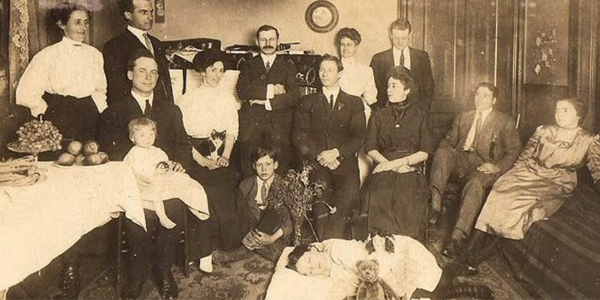
The period of the rule of Queen Victoria is known for the high childhood mortality rates. Kids often died before they were 3 and the only picture of the entire family together was with a baby in a coffin.
Brothers and Sisters Would Pose Alongside Their Deceased Siblings

Hard to imagine the process of shooting such a photo, but that was like a way of commemorating a deceased child. Living siblings, frequently with their mother, posed alongside their dead brothers and sisters.
Mothers Would Hide Behind a Sheet While Holding Their Deceased
The main idea of such Victorian era photoshoot is to photograph a child, either dead or alive, sitting still and motionless, while a mother is covered with a white sheet, like a kid is alone in the shot. Sound a bit ridiculous, but this approach was widely-used at that time.
It is very difficult to say whether a baby is alive in such “hidden mother” images, as the scene and the model were well-prepared.
Standing Dead
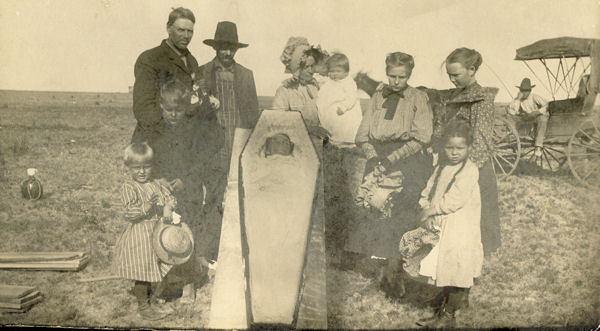
Photographs of dead people are a very popular and much-hyped part of Victorian photography history. You can find many similar photo selections on the web: handsome, elegant men, pretty women, and most often, children with their eyes closed are half-sitting or are lying surrounded by living relatives.
It isn’t always possible to say that the central hero of the composition is already in a better place. Such images were widespread in Europe and America in the second half of the 19th century.There really existed the books of the dead. There were even photographers specializing in shooting the dead - both individually and in a circle of still living family members. Most often, they photograph children and old people.
Special Stands and Chairs Often Held Up the Bodies of the Deceased

Photographers used various kinds of stands and supports to make dead people look like they were full of life and energy.
Hidden Mothers
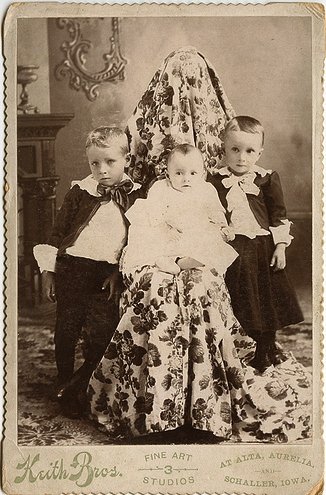
Many families didn’t have photos of their children when they were still alive, because it was very difficult to make a baby sit still, considering, that photographers used long exposures. If it was necessary to photograph a child alone, without a mother, photographers of the 19th century used a simple trick.
Mother sat on a chair, and she was carefully draped, covering her hands, face, legs with cloth, as if she were a piece of furniture. The child was placed on his/her mother’s lap, where he sat calmly for a while. At the same time, everything looked as if there was no one except a kid in suchVictorian era photos.
However, looking closer, you can notice a person under the veil sitting motionless, which makes you horrified. It seems that the creature is about to jump out and gobble up an unsuspecting innocent child.
Victorian Era Photoshop
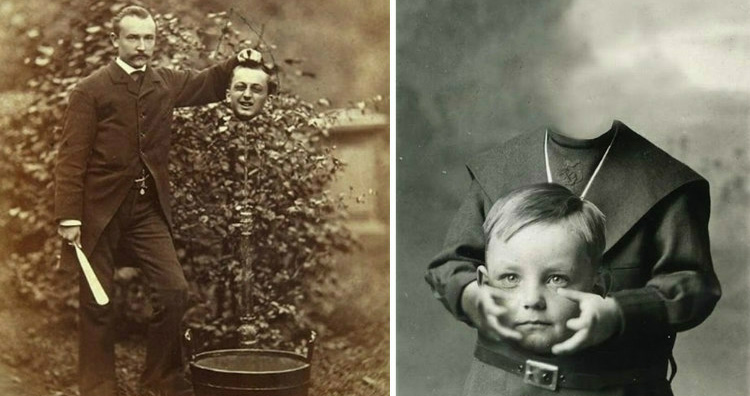
On May 23, 1878, the young British photographer Samuel Kay Balbirni from Brighton placed an ad in the Brighton Daily News newspaper, which later became famous and gave rise to a whole genre of photo manipulations.
It stated: “Photographs of perfumes: ladies and gentlemen in the photographs will fly in the air accompanied by tables, chairs and musical instruments! Headless photos: ladies and gentlemen in the pictures will hold their own heads in their hands! Photos of dwarfs and giants: this is really funny!”

There were enough photographers in Brighton, and Balbirni, who opened the photo studio, wanted to stand out. He invented a method of photo manipulation based on combining several negatives.In fact, this was the forerunner of modern Photoshop.
Oddly enough, Balbirni’s idea did not succeed. Accustomed to traditional Victorian portraits, the residents of Brighton were in no hurry to be photographed in a headless or flying form. Two years later, the photographer closed his studio and became an army doctor.
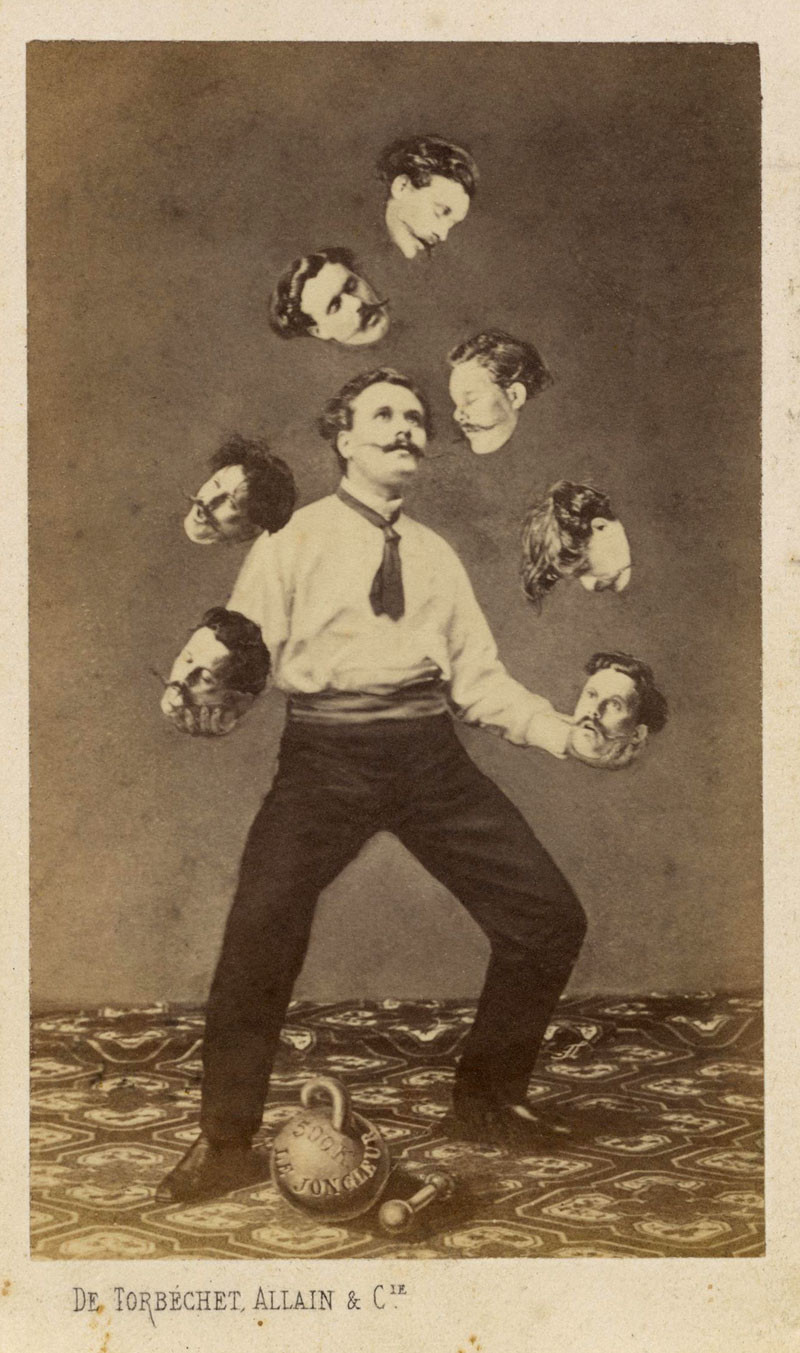
However, his initiative was picked up on. Some photos taken by Balbirni were stored not only in clients’ albums, but also appeared in newspapers. As a result, dozens of photographers in England and abroad mastered the simplest manipulation with negatives. “Headless Portraits” became a popular genre of photography and remained in fashion until the 1910s.
- Find out more about the history of photo retouching.
Exploding Mule
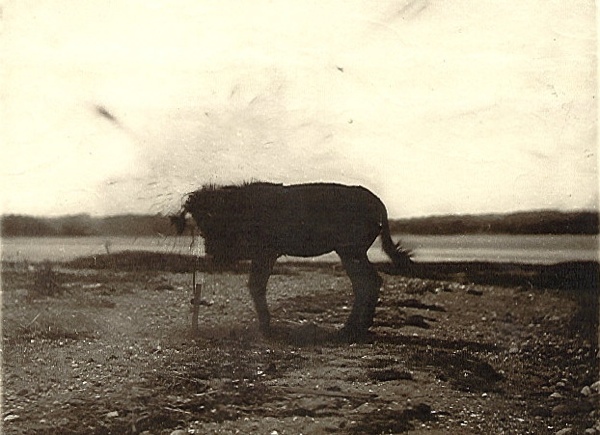
The most famous headless photograph does depict ahuman, but a mule. And the mule in it really has no head!It was made by British photographer Charles Harper Bennett on June 6, 1881, exclusively for scientific purposes.
Bennett was the son of a Surrey hatter, but in the 1870s decided to start a business selling photo equipment. In 1878, trying to find a way to reduce shutter speed, he realized that the collodion process could not be accelerated and that he needed a radically new composition of the emulsion to instantly fix the frame.
By then, another photographer, the English physician Richard Maddox, had already achieved success in this area by replacing collodion with gelatin. But he also could not get a sufficient speed because there was too much liquid in the gelatin. Bennett decided to improve Maddox’ method and quickly achieved success. He managed to reduce shutter speed from a few seconds to 1/25 of a second.
First, Bennett decided to show the technology to the American military, and he needed a spectacular and, at the same time, effective experiment. He tied dynamite to the mule’s neck, mounted a camera on a tripod, and then blew up the animal’s head in the presence of U.S.
Army lieutenant colonel Henry Abbott and several other military men from Willets Point Base (New York).He managed to take a picture at that moment when the fragments of the mule’s head were already scattered, but the body was still standing. This demonstrated the speed of shooting.
Treatment or Torture?

Other popular Victorian times images show people who are being tortured by someone. Theyare sitting in the electric chair or their head is wedged in a vise. Most of such photos have a logical implied sense. For example, you may have seen an image of a slender, half-naked woman tied by her hands to a strange cone-shaped frame.

Nearby there is a fully dressed middle-aged man, who seems to be looking at the woman’s chest. Is it something vulgar? Of course not.This photograph just illustrates the scoliosis correction technique developed by the famous American orthopedic surgeon Lewis Sayre.
Duchenne Shoemaker
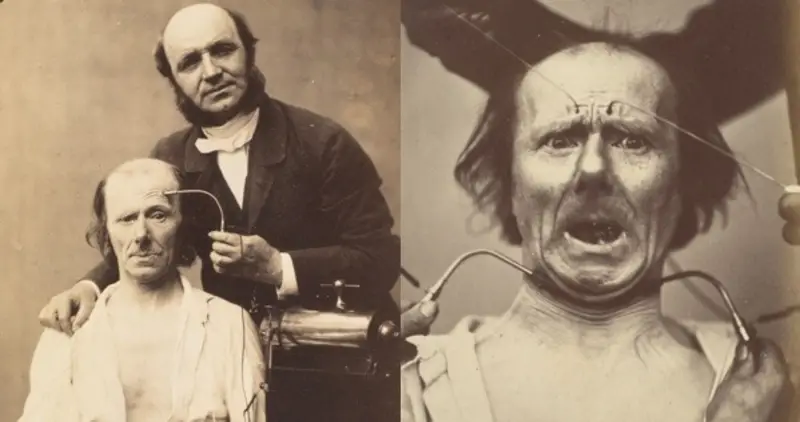
Guillaume Duchenne, a French neurologist who lived in the 19th century, examined the response of muscles and nerves to electrical impulses. Subsequently, his work formed the basis of electroneuromyography, a diagnostic test to detect nerve damage.
Besides, Duchenne captured the facial expressions of patients when applying impulses to a particular facial nerve. The problem was the long exposure, as Duchenne couldn’t capture the body reaction. But Duchenne was lucky - he had a middle-aged shoemaker, who suffered from facial paralysis (Bell’s palsy).
In other words, the expression on the patient's face remained there unchanged for several minutes until the muscle was "released". This made it possible to take a high-quality shot at slow shutter speed. The doctor did over 100 experiments with the shoemaker, connecting the electrodes to various muscles and getting a variety of facial expressions. The study, equipped with images, was published under the title "The Mechanism of Human Physiognomy."
Thanks to this work, Duchenne determined the purpose of a number of facial muscles and, in particular, revealed the mechanism of how a smile appears.



